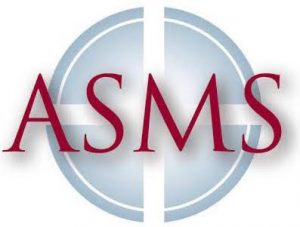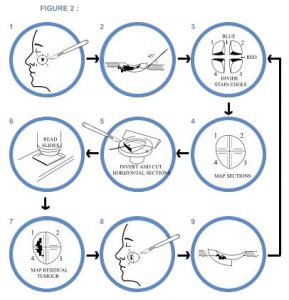 Dr. Rueckl was trained in Mohs in Irvine, CA and has been performing Mohs surgeries for over 25 years. He is board-certified by the American Society for Mohs Surgery. He has performed thousands of these types of skin cancer surgeries.
Dr. Rueckl was trained in Mohs in Irvine, CA and has been performing Mohs surgeries for over 25 years. He is board-certified by the American Society for Mohs Surgery. He has performed thousands of these types of skin cancer surgeries.
What is Mohs micrographic surgery?
Mohs micrographic surgery is a specialized, highly effective technique for the removal of skin cancer. The procedure was developed in the 1930s by Dr. Frederic Mohs at the University of Wisconsin, and is now practiced throughout the world. Mohs surgery differs from other skin cancer treatments in that it permits the immediate and complete microscopic examination of the removed cancerous tissue, so that all levels and extensions of the cancer can be eliminated. Due to the methodical manner in which tissue is removed and examined, Mohs surgery has been recognized as the skin cancer treatment with the highest reported cure rate. Many dermatologists have not been trained to perform Mohs surgeries, as it is an extensive, post-degree program.
What skin cancers require Mohs?
It is important to note that Mohs surgery is not appropriate for the treatment of all skin cancers. Mohs micrographic surgery typically is reserved for those skin cancers that have recurred following previous treatment or for cancers that are at high risk for recurrence. Mohs surgery also is indicated for cancers located in areas such as the nose, ears, eyelids, lips, hairline, hands, feet, and genitals, in which maximal preservation of healthy tissue is critical for cosmetic or functional purposes.
Some skin cancers can be deceptively large—far more extensive under the skin than they appear to be from the surface. These cancers may have “roots” in the skin, or along blood vessels, nerves, or cartilage. Skin cancers that have recurred following previous treatment may send out extensions deep under the scar tissue that has formed at the site. Mohs surgery is specifically designed to remove these cancers by tracking and removing these cancerous “roots”. For this reason, prior to Mohs surgery it is impossible to predict precisely how much skin will have to be removed. The final surgical defect could be only slightly larger than the initial skin cancer, but occasionally the removal of the deep “roots” of a skin cancer results in a sizeable defect. The patient should bear in mind, however, that Mohs surgery removes only the cancerous tissue, while the normal tissue is spared.
What is a Mohs procedure like?
Prior to your procedure, you will sign a consent and full details of the procedure will be covered. You should expect to spend at least a few hours in our office for this procedure as it requires multiple steps and specialized lab technology.
During the first stage of the Mohs procedure, the area to be treated is cleansed, marked, and injected with local anesthetic. Dr. Rueckl will then remove the visible cancer along with a thin layer of additional tissue. The site where the tissue was removed is then packed with gauze and the patient is directed into the conference room to wait while the tissue is processed and examined. The removed tissue is then cut into sections, stained, and marked on a diagram by a specialized Mohs lab technician. The tissue is then frozen on a cryostat and thin slices of the tissue are stained and placed on slides for Dr. Rueckl to examine. During examination of the slides, Dr. Rueckl is looking for any residual cancer or “roots”. If any are found, the patient returns to the surgical room and additional tissue is taken only from the affected area. The steps above are completed again, as necessary, until no remaining tumor is present. The length of the procedure depends on how many levels of tissue must be removed. The steps of a typical Mohs surgery are shown below.

After the skin cancer has been removed, Dr. Rueckl will close the site with either a simple or complex wound repair (in some cases this can include a skin graft from another area) or by leaving the wound open to heal naturally. Dr. Rueckl will choose the best closure method for the size and location of the removed skin cancer. Sutures used to close the site will be removed approximately one week later at another appointment.
What kind of results can I expect from Mohs?
The purpose of Mohs is to remove any skin cancer with the smallest possible margins of cutting. As with all forms of surgery, a scar will remain after the skin cancer is removed and the surgical area has completely healed. Mohs micrographic surgery, however, will leave one of the smallest possible surgical defects and resultant scars. Should the scar’s appearance bother you after the site has completely healed, further procedures to improve their appearance can be discussed.
Most patients do not complain of significant pain post-procedure. If there is any discomfort, usually Tylenol (not aspirin, Advil, or Aleve) is best. Stronger medications may be prescribed by Dr. Rueckl if necessary. You will most likely experience some swelling and bruising around the area as well but that should subside within a few days. Some itching as the site heals or drainage of fluid or blood from the area may also occur.
It is important to keep the area clean. Instructions for cleaning the site, including topical medication, will be given to you by Dr. Rueckl or the Medical Assistant after the procedure. Please follow these directions and return in a timely manner for your suture removal, as scheduled.
How much does Mohs cost?
Because of the time and skill involved, Mohs is a more expensive procedure than a simple excision or biopsy. That being said, most insurance companies cover the costs of Mohs surgeries and the reconstruction of the resultant surgical area. If your primary insurance is one that we take, your insurance will be billed by our office. Any applicable co-payments are due at the time of the procedure. Any amounts applied to your deductible or co-insurance amounts deemed by your insurance plan will be billed and due by you also. Should your insurance company not cover the procedure cost, you will be responsible for all associated balances. Patients who do not have insurance or are on a plan we do not take will be responsible for all costs, and payment is expected in full the day of the procedure.





